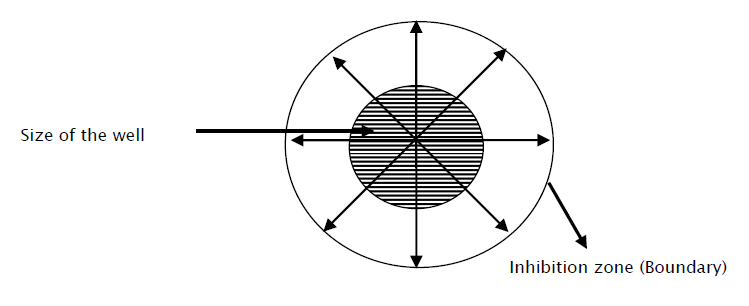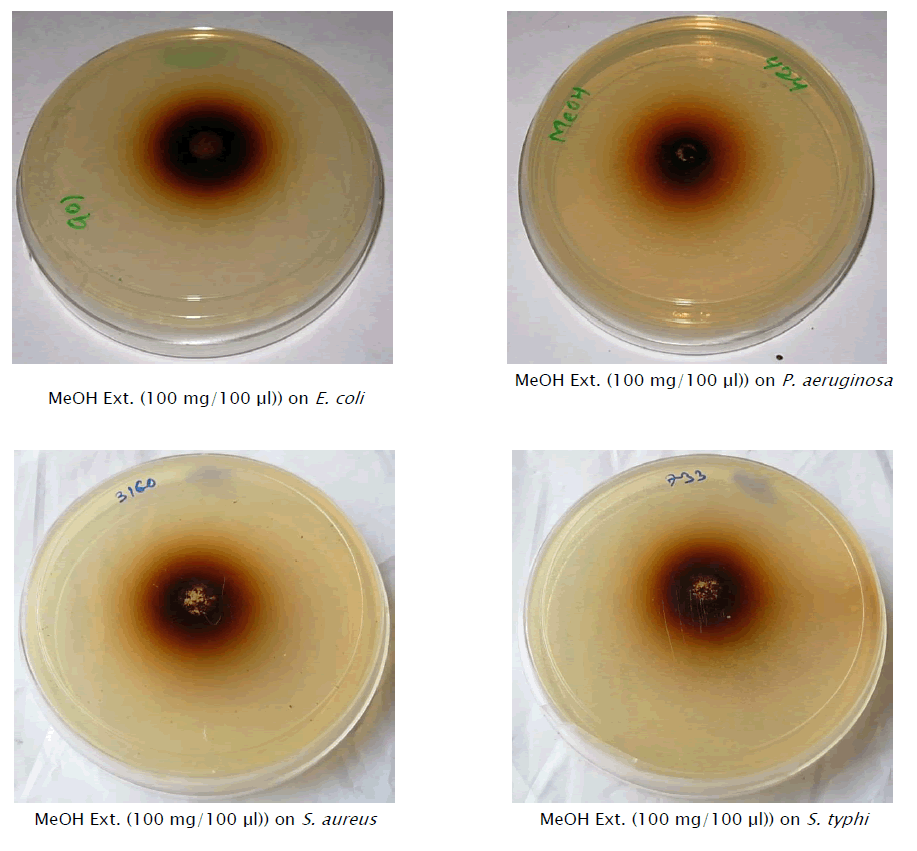E- ISSN: 2320 - 3528
P- ISSN: 2347 - 2286
E- ISSN: 2320 - 3528
P- ISSN: 2347 - 2286
National Institute of Ayurveda, Madhav Vilas Palace, Amer Road, Jaipur – 302002, Rajasthan, India
Received date: 15/02/2013 Accepted date: 06/03/2013
Visit for more related articles at Research & Reviews: Journal of Microbiology and Biotechnology
Presently there is an increasing interest in the case of plant microbicides because of the necessity to finding safer microbicides and the need for preventing environmental degradation. The methanolic extract of bark of Holoptelea integrifolia Roxb. (Ulmaceae) in different concentration was evaluated for antimicrobial activity against various bacteria viz. Streptococcus pyogenes MTCC No.1928, Staphylococcus aureus MTCC No. 3160, Escherichia coli MTCC No. 901, Pseudomonas aeruginosa MTCC No. 424 and Salmonella typhi MTCC No. 733. For the calculation of zone of inhibition Agar well diffusion method was adopted.
Holoptelea integrifolia, Antimicrobial activity, Zone of inhibition.
From the Earliest times, herbs have been prized for their pain reliving and healing abilities and today we still relay on the curative properties of plants in about 75% of our medicines. In Ayurveda the traditional Indian medicine about 2000 plant species are considered to have medicinal value. It‟s estimated that around 70,000 plant species from inches to towering trees, have been used for medicinal purpose.
Plants have a great potential for producing new drugs of great benefit to mankind. There are many approaches to the search for new biologically active principles in higher plants [1]. The increasing prevalence of multi drug resistant strains of bacteria and the recent appearance of strains with reduced susceptibility to antibiotics raises the specter of untreatable bacterial infections and adds urgency to the search for new infection-fighting strategies [2].
In Ayurvedic system of medicine, a large number of plants are being used for treating diseases of bacterial origin and good results have been obtained with some of them but scientific investigation and information of the therapeutic potential of these plants is limited. So systematic screening of them may result in the discovery of novel effective compounds [3]. In the same concern the present study was conducted to assess the antimicrobial activity of methanolic extract of bark of Holoptelea integrifolia.
Keeping on the view of the above mentioned problem, the study was carried out on plant “Holoptelea integrifolia” (CHIRBILWA) in order to explore it‟s Antimicrobial activity based on reference mentioned in Guduchyadi varga of Bhavaprakash Nighantu. It is also considered as one of the variety of Karanja. It is a large deciduous tree, 15-18 m high, distributed throughout the greater part of India with Greenish yellow flower and one seeded light brown winged fruits belongs to family Ulmaceae having Tikta, Kasaya rasa, Laghu, ruksha guna, Ushna Virya and katu vipak. It is described under Lekhaniya Mahakasaya & Bhedaniya Mahakasaya of Charak Samhita and Varunadi Gana of Sushruta Samhita. It is useful cholic pain, intestinal worms, filaria, piles, pox, vitiligo [4] and also in wound healing [5].
Plant Material
Fresh bark of main trunk of Holoptelea integrifolia was collected from National Institute of Ayurveda campus, Jaipur in the month of January. The plant material was identified and authenticated by Prof. M.C. Sharma, Deptt. of Davya Guna, National Institute of Ayurveda, Jaipur (Rajasthan). After the collection of plant material they were cut into small pieces and shade dried.
Preparation of Extracts
For the aqueous extraction of plant material the „Hot extraction method‟ was used recommended by W.H.O. (Quality Control Methods for Medicinal Plant Materials). 30 gms of shade dried macerated material of Holoptelea integrifolia was added to 300 ml. of Methanol in a glass-stoppered round bottom flask. The mixture was then shacked well and allowed to stand for 1 hour. Then reflux condenser was attached to the flask and boiled gently for 1 hour, cooled, shacked well and filtered through a dry whattman filter paper. The filtrate was then poured into sterile beaker and evaporated to dryness on a water bath at 60°C. It was cooled in desiccators for 30 minutes and weighed without delay, where 22.35% extractive value was found. This residual was brown colored and transferred to a moisture free test tube and made it air tight by means of a cork.
Microorganism
Microorganisms for the present study were obtained from Institute of Microbial Technology (IMTECH), Chandigarh (INDIA) and the stock cultures were maintained at 4°C on the following media as mentioned in table given below:
Revival of Microbial Cultures and Inoculation
Like all other living forms, micro-organisms need suitable nutrients and favourable environments for growth. A simple way to obtain bacteria is to grow them in a test tube/ or a small flask in broth medium.
The cultures, which were procured from IMTECH, were in freeze-dried form (i.e. in dormant state). So, their revival was necessary. For this, 250 ml Nutrient broth medium was made and transferred in five small conical flasks (of quantity 100ml) 50ml each. Since, our laboratory study was dealing with pure cultures that are with single species of micro-organisms, sterilization of broth media becomes mandatory. The flasks were capped with cotton plug and autoclaved at 121ºC for 20 minutes at 15 lb pressure per square inch. When the temperatures of flasks came to at about room temperature, sterile human blood (5% i.e. 2.5 ml) was added in one flask aseptically. The glass tube containing bacteria in dormant stage was broken and 0.5 ml of above Nutrient broth was transferred into the broken tube and mixed thoroughly. Out of which 50 micro liters was taken, mixed with concerned flask and capped with cotton plug. For bacteria 1928 same process was adapted to the flask contains broth with blood.
Then mouth of the flasks were again covered with aluminum foil and allowed them to stay in incubator at 200 rpm and 37°C temperature for 24 hours. After 24 hours the turbidity in each flask confirms the growth of culture and placed them into the freezer for further use.
Antimicrobial Assay
The antimicrobial assay was performed by agar well diffusion method [6]
The disc was saturated with 100 μl of the test compound, allowed to dry. For agar well diffusion method, a well of 8 mm diameter was prepared in the plate. 100 μl of the extract was then introduced into the well. The plate was incubated at 37°C for 24 hrs. and then observed for presence of inhibition zone.
Measurement of Inhibition Zone

The zone of inhibition of bacteria growth around the well was measured in mm, with the help of a scale. The readings were taken at 4 different planes as shown in figure above:
Then the mean was calculated of the four readings taken [7].
The results were based upon the scale developed by Arora and Bhardwaj, 1997. The zone of inhibition and result of drug sensitivity was described as below.
Streptococcus pyogenes (1928): Methanolic extract of bark of Holoptelea integrifolia shows insensitive at the dose levels of 50mg, 75 mg and 100mg.
Staphylococcus aureus (3160): Methanolic extract of bark of Holoptelea integrifolia shows moderate sensitivity at the dose levels of 50mg, 75 mg and highly sensitivity at 100mg.
Escherichia coli (901): Methanolic extract of bark of Holoptelea integrifolia shows highly sensitivity at the dose levels of 50mg, 75 mg and 100mg.
Pseudomonas aeruginosa (424): Methanolic extract of bark of Holoptelea integrifolia shows less sensitivity at the dose levels of 50mg, 75 mg and moderate sensitivity at 100mg.
Salmonella typhi (733): Methanolic extract of bark of Holoptelea integrifolia shows moderate sensitivity at the dose levels of 50mg, 75 mg and highly sensitivity at 100mg.
Zone of inhibition:
The inhibition zone with most significant results

Probable mode of action according to Ayurvedic view
As per Ayurveda the properties of tikta rasa are – Krimighna, Deepana, Pachana, Kapha sosana etc [8].
• As the drug having tikta rasa, so it directly acts on the krimis & kills them.
• Secondly most of the internal krimis were formed from phlegm (kapha), as the drug having Tikta & Kasaya Rasa, Laghu & Ruksha Guna, Ushna Virya & Katu in Vipak, it pacify the kapha & inhibit further formation of Krimis.
• Thirdly when we consume improper food, Ama rasa is produced due to improper digestion & it vitiates rakta and kapha and krimis were produced. As tikta rasa having deepan & pachan property, it maintains the digestion proper and prevents the formation of Ama hence prevent the formation of Krimis.
Probable mode of action according to modern view
• The previous research works tells us that the secondary plant metabolides, like Terpenes , Tannins, Saponins, Phenols shows antimicrobial activity [9,10,11,12]. As this experimental plant contains the same active ingredient [13], so it is probably the cause of antimicrobial activity. However, further study is also required to know which component is most responsible for this.
• The experimental study only tells that different concentrations plant extract are effective against Microorganism, where further study is required to explore that how much it is potent and efficacious as compared to a standard anti-microbial agent like ciprofloxacin, Roxithromycin etc. because no standard comparator was taken during the present experiment.
• All the experiments were carried out in well method; therefore further analysis is required to explore the antimicrobial activity by disc diffusion method.
The authors are thankful to Dr. V.K.Nigam(Scientiest), Birla Institute of Scientific Research, Jaipur for conducting the antimicrobial assay.